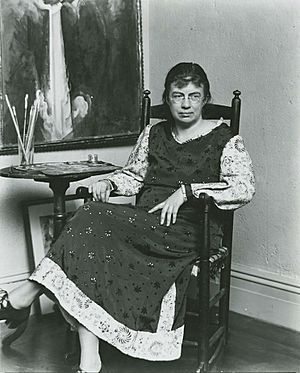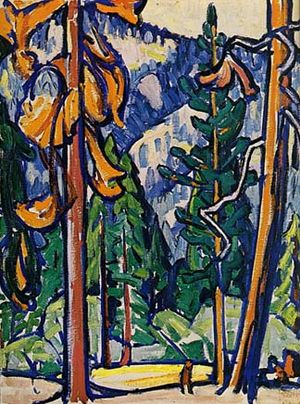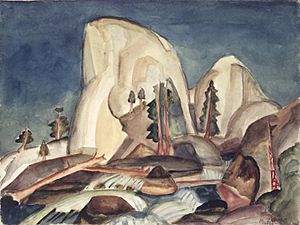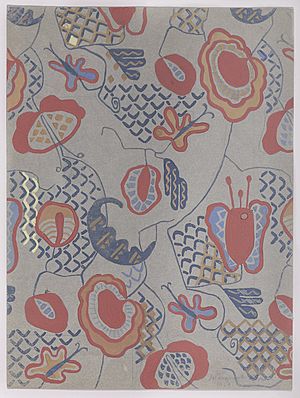Marguerite Zorach facts for kids
Quick facts for kids
Marguerite Zorach
|
|
|---|---|

Zorach in her studio
|
|
| Born |
Marguerite Thompson
September 25, 1887 |
| Died | June 27, 1968 (aged 80) New York City, US
|
| Known for | painting |
| Spouse(s) | |
| Awards | Logan Medal |
Marguerite Zorach (born Marguerite Thompson; September 25, 1887 – June 27, 1968) was an amazing American artist. She was a painter, textile artist, and graphic designer. She was one of the first artists to bring modern art to America. In 1920, she won a special award called the Logan Medal of the Arts.
Contents
Early Life and Art Beginnings
Marguerite Thompson was born in Santa Rosa, California. Her family had roots in New England and Pennsylvania. When she was young, her family moved to Fresno. There, she started her education.
Marguerite loved to draw from a very young age. Her parents made sure she had a good education. This included music lessons and learning Latin in high school. In 1908, she was one of the few women accepted into Stanford University.
Becoming an Artist
Art Studies in Paris
While at Stanford, Marguerite showed a lot of talent for art. Instead of finishing her degree, she went to France. Her aunt, Harriet Adelaide Harris, invited her. On her first day in Paris, Marguerite visited a famous art show called the Salon d'Automne.
There, she saw many paintings by Henri Matisse and André Derain. These artists were part of a group called the Fauvists. They were known for using bright, unusual colors and bold brushstrokes. Seeing their art really inspired Marguerite. She decided to study at the Académie de La Palette. This school encouraged her to paint in her own unique style. She showed her art in important modern art shows in 1910 and 1911.
In Paris, she met famous artists like Pablo Picasso and Henri Rousseau. She also met William Zorach, who would later become her husband. William was amazed by her art. He said he couldn't understand why "such a nice girl would paint such wild pictures."
World Travels and New Ideas
After her time in Paris, Marguerite went on a long trip around the world. This was in 1911 and 1912. She visited places like Jerusalem, Egypt, India, China, Japan, and Hawaii. She was very impressed by these new cultures. She even wrote articles about her travels for her hometown newspaper.
This trip greatly changed her art. She started painting in a more abstract way. Her paintings became very colorful, with thick black outlines. The trip ended when she returned to California in 1912.
Return to America and Marriage
When Marguerite came back to the US, she spent time in the beautiful Sierra Nevada mountains. Her parents, however, did not approve of her art. This made her destroy many of her early works. She then moved to New York City. On December 24, 1912, she married William Zorach.
Marguerite and William immediately started creating art together. They both showed their work in the famous 1913 Armory Show. They continued to be successful. In 1915, Marguerite had a son named Tessim. In 1917, she had a daughter named Dahlov. The family settled in Greenwich Village. Their home became a meeting place for other artists to share ideas. Every summer, they would spend time in the countryside of New England.
Marguerite also led the New York Society of Women Artists in the 1920s. This group supported modern women artists.
Summer in Yosemite
One special summer for Marguerite and William was in 1920. They spent it in Yosemite Valley, painting the amazing landscape. The family hiked, sketched, and painted the national park. They used the bright, bold style of the Fauvists. This trip deeply influenced them. Themes from Yosemite appeared in many of their later artworks.
Creating Art with Textiles
After her daughter was born, Marguerite found a new way to create art. She started working with textiles, like fabric. This allowed her to spend more time with her children. Both William and Marguerite tried textile art. But Marguerite became more famous for it.
She made beautiful embroideries and batiks. These fabric artworks looked like her colorful Fauvist paintings. Her embroideries were first shown in New York in 1918. People really liked them. Using textiles for art was a new idea at the time. It helped break down the idea that crafts were not as important as fine art.
Marguerite's textile works were popular. They often helped the family financially. She also loved making unique clothes for her husband and children.
Later Life and Legacy
Marguerite Zorach continued to create art throughout her life. During the Great Depression, she worked for the Works Progress Administration. She painted large murals for post offices. One mural, New England Post in Winter (1938), is in Peterborough, New Hampshire. Another, Autumn (1940), is in Ripley, Tennessee. She also taught art at Columbia University.
Later in life, Marguerite had an eye condition called macular degeneration. This made it hard for her to do detailed textile work. However, she was still able to paint. She passed away in New York in 1968.
For a long time, Marguerite Zorach was not as well-known as her husband. But after her death, she started to get the recognition she deserved. She was a very talented painter. She played a big part in bringing modern art to the United States. Many art experts now call her the "First Woman Artist of California."
Art in Museums
Many museums now have Marguerite Zorach's artwork. The Smithsonian American Art Museum has over 200 pieces. The Metropolitan Museum of Art also has several of her paintings. Her mural, Hay Making (1942), can be seen in the Monticello, Indiana post office.
Awards and Exhibitions
In 1964, Marguerite Zorach received an honorary degree from Bates College. After her death, several special art shows celebrated her work. In 2007, the Gerald Peters Gallery held a show of her art. In 2010, her watercolors were shown at the Michael Rosenfeld Gallery. A big show of her work was also held at Franklin & Marshall College in 2011.
Images for kids
See also
 In Spanish: Marguerite Thompson Zorach para niños
In Spanish: Marguerite Thompson Zorach para niños








